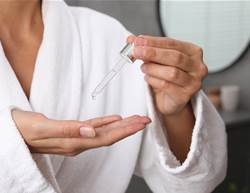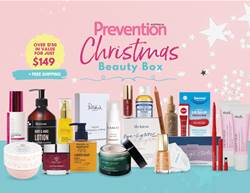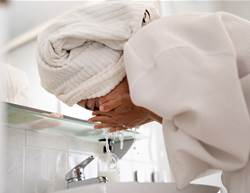Having oily skin isn’t all bad. Those natural oils protect and preserve the skin—meaning people with that natural glow typically have fewer wrinkles, according to the American Academy of Dermatology. But with those perks comes quite a few annoyances, like a super-shiny face, clogged pores, breakouts, and the horror of watching your makeup melt off by mid-afternoon.
So what causes oily skin, anyway? “On a biological level, oily skin is caused by hormonal stimulation of the sebaceous glands (oil glands),” says dermatologist Dr Melanie Palm. “Oil produced is excreted from the gland through our pores to the surface of the skin, causing a characteristic shiny or slick appearance.”
Oil glands tend to be clustered in certain areas of the face, including the forehead, nose, mid-cheeks and chin (better known as the T-zone), says dermatologist Dr Tsippora Shainhouse. That’s why these areas tend to look super-greasy if you’re prone to oily skin.
The amount of oil that’s produced varies from person to person, and things like hormonal changes (menstruation, pregnancy, menopause), diet, stress, and even the weather can all influence the amount of oil churned out by your skin. Fortunately, there are plenty of things you can do to get oily skin under control, and we went to the experts to find out exactly what to do.
1. Read the labels on your skincare products
Certain keywords and ingredients can indicate whether skincare products will help you tame oil production or make it worse. “Use products labelled with terms like ‘non-comedogenic,’ ‘non-acnegenic,’ ‘doesn’t clog pores,’ or ‘won’t cause breakouts,’” says dermatologist Dr David Lortscher.
“This indicates the manufacturer considers the product to be designed for people with oily or acne-prone skin.” It’s not a guarantee, he adds, since everyone’s skin reacts differently, but it can be a useful guideline.
Also, look for active ingredients that help the oil gland function more normally, like salicylic acid, benzoyl peroxide, niacinamide, zinc, retinoids and sulfur. “Lighter formulations are likely to be better tolerated—these include serums, gels, lotions, or powders, rather than creams or ointments,” says Dr Palm.
If you’re unsure about a product, Dr Lortscher recommends using cosDNA.com to research your skincare products in their database. Pull up and run the ingredient list through the “analyse cosmetics” section, and check out the “acne” column: If there are any 3s, 4s, or 5s listed, consider swapping out the product for a different one.
2. Use an oil-fighting cleanser
Contrary to popular belief, you don’t need to use an aggressive face wash to de-grease your skin. In fact, going too strong may cause rebound oil production. Go with a gentle foaming cleanser instead, says Dr Lortscher, preferably one that contains salicylic acid or benzoyl peroxide, which penetrate your pores and keeps them gunk-free. Try the following options:
- Cetaphil Pro Acne Prone Oil Control Foam Wash
- Eau Thermale Avene Essential Care Cleansing Foam
- Ceramides Foaming Oil-Free Cleanser
3. Then, let your cleanser do the work
Scrubbing your skin can strip your skin of its natural protective oils and, paradoxically, trigger increased oil production. “The goal is to remove physical dirt and emulsify the excess oils and grease so they rinse off. It isn’t to irritate your skin,” says Dr Shainhouse. Simply wet your skin, and using a 5-cent-coin-sized amount of cleanser, lather up the product and gently massage it onto your face. Your cleanser will take care of the rest.
4. But don’t wash your face too often
It can be tempting to wash your face several times a day with oil-zapping cleansers to keep your skin looking matte, but doing so can actually backfire. “When you over-wash, you remove the protective natural oils, which can leave your skin feeling dry, tight, and parched,” says Dr Shainhouse. Because your skin can’t produce its own moisture, it responds to the dryness by making more oil. To stop this cycle, only wash your face in the morning, at night and after exercise.
5. Tweak your toner usage
Don’t use drying toners (think: alcohol-based), apple cider vinegar or rubbing alcohol to evict grease from your skin. “These solutions will physically remove surface grease, but dry out the top layer of your skin,” says Dr Shainhouse, and potentially lead to rebound oil production. If you feel like you need a toner step, Dr Shainhouse recommends going with a micellar water that contains both astringent (charcoal, witch hazel) and moisturising ingredients (glycerin, hyaluronic acid, aloe vera) to both mattify and protect your skin.
If your skin can tolerate micellar water without getting irritated, consider a gentle formula like La Roche-Posay Micellar Water For Sensitive Skin.
6. Never skip moisturiser
It seems counterintuitive to moisturise skin that’s always shiny and greasy, but doing so gives your skin an added layer of protection against rebound oil production, says Dr Shainhouse.
Apply a light, oil-free moisturiser after washing your face (or toning if you want to include that step), such EltaMD AM Therapy or Neutrogena Hydro Boost Water Gel.
7. Always wear sunscreen
Sunscreen doesn’t have to make your face look greasy, so long as you choose the right product for your skin type. Opt for a lightweight formula that contains mineral blockers, like zinc oxide and titanium dioxide, says Dr Shainhouse. Chemical formulations are fine too – just make sure to choose a gel or light liquid formula that’s made for faces.
8. Apply a mattifying agent
Applying a mattifying agent, after sunscreen and before makeup, can help control shine during the day. Dr Palm recommends OC8 Professional Mattifying Gel: “It contains a polymer called acrysorb, which attaches to and absorbs oil on the skin,” she says. Best of all, it helps to reduce shine for up to eight hours.
9. Switch up your makeup
Switching makeup products from creams to powders is a great way to keep excess oil in check, says dermatologist Dr Heidi Prather.
Creamy makeups can give off a cakey vibe and leave more room for clogged pores to take shape, whereas mineral-based powders are non-comedogenic and help to soak up shine. RMS Beauty “Un” Powder, for example. acts as a translucent setting powder, keeping oil at bay and minimising pores without any pesky white residue.
10. Exfoliate weekly
It’s important not to over-exfoliate or you can actually cause an uptick in oil production. Exfoliating once or twice a week should do the trick. “I generally recommend non-particle based chemical exfoliants that contain a combination of glycolic and salicylic acids,” says Dr Palm. This combo effectively lifts off excess oil and dead skin cells, preventing clogged pores in the process.
Try the Peter Thomas Roth Max Complexion Correction Pads after cleansing.
11. Add retinoids to your repertoire
Regular use of retinoids helps to shrink sebaceous glands and reduce oiliness, says Dr Prather. But take note: when you’re a newbie to retinoids, they can dry the skin’s surface and induce peeling, so you may find that you wake up with greasier skin in the beginning, that dissipates once your skin adjusts, says Dr Shainhouse.
Most retinoids require a prescription from your dermatologist. To help prevent the initial uptick in oil production, you can also start with a retinol cream at night (a gentler sister to retinoids) like Neutrogena Rapid Wrinkle Repair before you work your way up to a stronger formulation.
12. Apply a sulphur mask a few times a week
Not only does sulphur draw impurities out of the skin, it’s also anti-inflammatory, helping to calm irritation within the hair follicle-oil gland unit that can cause oil production to go into overdrive, says Dr Palm. Sulphur masks (like Kate Somerville’s EradiKate Foam-Activated Mask) should be rinsed off completely with water or a gentle cleanser. If skin feels tight post-mask, apply your go-to moisturiser to avoid rebound oil production.
13. Keep a stash of blotting papers handy
When you need to sop up excess oil on the go, blotting papers make for a convenient quick fix, says Dr Prather, who recommends using Tatcha Japanese Blotting Papers. They’re made with abaca leaf and gold flakes for a natural product that helps to absorb excess oil sans messing up your makeup. Gently press onto your face to absorb the oil, then mosey on with your day.
14. Mist your way to cool skin
Research suggests that hot and humid climates can trigger excess sebum production. (Cue sad trombone.) “Avoiding overheating during the spring and summer months can help to minimise the amount of sweat and oil production on the skin,” says Dr Prather. Water sprays, such as Avene Thermal Spring Water, can be misted onto your face to cool you off without increasing oil or shine.
15. Avoid touching your face
It’s super-tempting to touch your face, especially when you’re stressed out or deep in thought. But when your skin is already oily, the last thing you want to do is transfer more oil from your hands to your face, not to mention dirt and bacteria. “The repetitive action of touching your face can further clog pores and result in acne,” says Dr Prather. Only touch your face (with clean hands) when you’re cleansing or applying sunscreen, moisturiser, and makeup.
16. Cut back on sugar and refined carbs
Eating sugar and refined carbs, like white bread, sweet drinks and junk foods, causes your blood sugar levels to spike and your pancreas to release insulin to level things out, says Dr Lortscher. Insulin-like growth factor (IGF-1) production is stimulated, which can boost oil production and acne severity.
Do your best to nix sugar and refined carbs from your diet, and replace them with foods that are considered low GI (meaning they don’t spike blood sugar), such as high-fibre, unprocessed foods; whole grains, seeds, legumes, veggies and many fruits (strawberries, peaches, mangoes).
17. Drink spearmint tea
The science is not crystal clear yet, but there’s some convincing evidence that drinking two cups of organic spearmint tea per day can reduce blood levels of circulating androgens, which are male-type hormones that all women have.
“Androgens trigger oil gland production, and can worsen acne, so reducing levels of circulating androgens through drinking spearmint tea may conceivably help oiliness,” says Dr Lortscher. If you want to give it a whirl, stick to just two cups per day, and keep tabs on your shine level.
18. Get your stress levels in check
“During stressful times, our bodies tend to produce more cortisol, and this also triggers excess oil production,” says Dr Lortscher. Do your best to create pockets of time throughout the day to partake in stress-busting practices, such as relaxation techniques (yoga, deep breathing), workouts (power walking, dancing), and downtime rituals (dinner with buds, Netflix and actually chilling).










